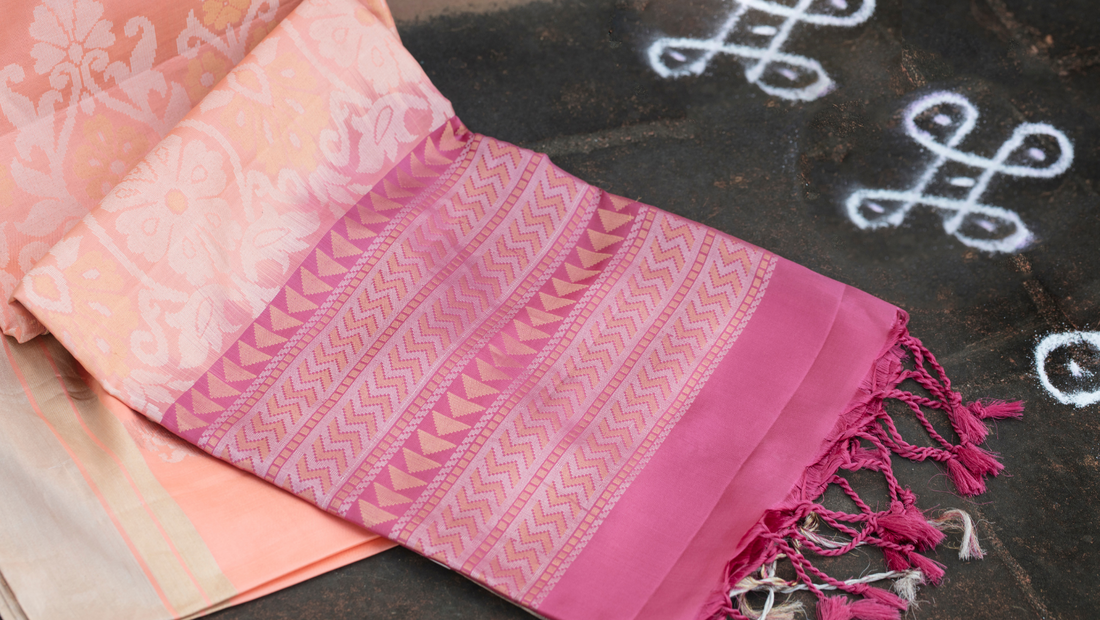
Threads of a Legacy: Weaving a Global Legacy with Indian Textiles
Share
For centuries, India's identity has been woven into its textiles. From the serene landscapes of Kashmir to the vibrant bazaars of Varanasi, each region has perfected a unique craft, a language told in silk, cotton, and wool. These aren't just fabrics; they are cultural ambassadors, carrying stories, history, and the skilled touch of artisans across oceans and generations. Today, these ancient traditions are more than just heirlooms; they're celebrated on runways, in homes, and in the hearts of people worldwide.
Brocade: The Fabric of Royalty and Grandeur
Step into the regal world of Banarasi brocade, a textile synonymous with opulence and tradition. Woven in the ancient city of Varanasi, this fabric is known for its intricate patterns created with gold and silver "zari" threads. The technique, perfected under Mughal patronage, fuses Indian artistry with Persian motifs. Today, a Banarasi sari is a prized possession for brides and a symbol of prestige. The shimmering motifs of leaves, flowers, and animals make it a living tapestry of history and grandeur, recognized globally for its sheer brilliance.
Pashmina: The Ultimate in Softness and Luxury
High in the Himalayan mountains, a unique story of luxury begins. Pashmina, a wool so fine and soft it was once called "woven wind," is sourced from the undercoat of the Changthangi goat. Hand-spun and hand-woven by skilled Kashmiri artisans, a true Pashmina shawl is an icon of elegance. Its journey to global fame was cemented in the 18th century when it captivated European royalty, most notably Empress Joséphine of France. Today, this luxurious textile continues to be a timeless statement piece, valued for its warmth, lightness, and unparalleled craftsmanship.
Ikat: The Art of the Imperfect Pattern
Ikat is a testament to the beauty found in precision and human touch. The name itself, from the Malay-Indonesian word for "to tie," describes the unique resist-dyeing technique where threads are tied and dyed before they are woven. This pre-dyeing process results in patterns with a soft, feathery "blurriness" that is impossible to replicate with a machine. While the craft is found in many cultures, Indian Ikat, with its vibrant geometric and symbolic motifs, has found a special place in global fashion. Its handcrafted nature and distinct patterns make it a favorite for designers seeking to add a touch of authentic, bohemian elegance to their collections.
Kalamkari: A Storyteller’s Canvas
Kalamkari, which literally means "pen-craft," is a traditional art form of hand-painting and block-printing on cotton fabric. Originating in Andhra Pradesh, this textile is a visual narrative, with motifs often depicting scenes from Hindu epics and folklore. The entire process, from preparing the fabric to creating the natural dyes, can take up to 23 meticulous steps. This ancient storytelling tradition has found new life in modern fashion and home décor, with its rich, earthy colors and intricate, handcrafted designs appealing to a global audience that values authenticity and artistic heritage.
A Legacy Woven in Every Thread
These textiles are more than just beautiful fabrics; they are living artifacts that bridge the past with the present. They represent a sustainable model of production, where every piece is a labor of love that supports communities and preserves centuries-old knowledge. In a fast-fashion world, the global recognition of Indian textiles is a powerful statement about the enduring value of tradition, artistry, and the human hand.
